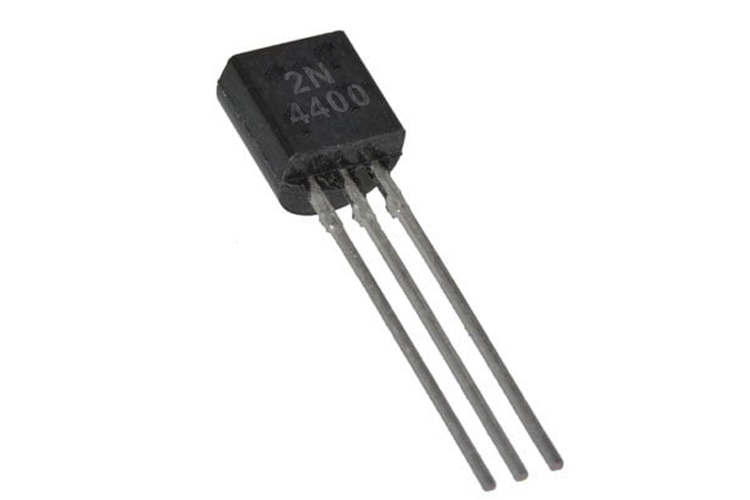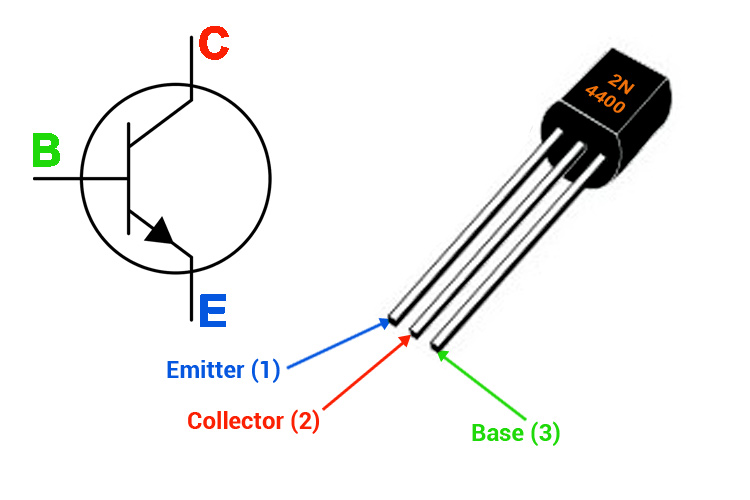2N4400 General Purpose NPN Transistor
The 2N4400 is an NPN Transistor in a TO-92 package, it has a VCE of 100V and a continuous collector current of 1A. With this characteristic and 1W total power dissipation, this transistor can be used in moderately high voltage switching applications.
2N4400 Pinout Configuration
|
Pin Number |
Pin Name |
Description |
|
1 |
Emitter |
Electrons emitted from the emitter into the first PN junction |
|
2 |
Base |
Controls the biasing of the transistor |
|
3 |
Collector |
Electrons Emitted from Emitter Collected by the Collector |
Features and Specifications
- Bi-Polar NPN, high voltage Transistor
- Collector-Emitter Voltage, VCE 40V
- Collector-Base Voltage, VCB 60V
- Emitter-Base Voltage, VEB 6V
- DC Current Gain (hFE) is 150 maximum
- Continuous Collector current (IC) is 600mA
- Base Current (IB) is 50mA maximum
- Collector Dissipation: 625 mW
- Transition Frequency:200 MHz
- Collector Capacitance 30pF
- Input Impedance 7.5K, where IC 1mA, VCE 10V, F 1KHz
- Operating Junction Temperature Max (Tj): 150 °C
- Available in TO-92 Package
Note: Complete technical details can be found in the 2N4400 datasheet given at the end of this page.
2N4400 Equivalent
General Description of 2N4400 Transistor
The 2N4400 transistor is a very versatile transistor that can be used in many different applications. This transistor can be used where you want to switch moderately high voltage devices, like a small DC-DC converter, or a pre or mid amplifier stage of a power amplifier, generally, a power amplifier uses something like 45 to 60DC. This device is cheap and easy to work with, so it is best suited when choosing a random switching device. When this transistor is in a biased condition, then it can allow a maximum current of 0.625A across CE(Collector-Emitter) Junction, this state of the transistor is called the saturation state, and driving a load that consumes more current than 0.625A may damage the device permanently, also during the design process, you need to be aware that the maximum dissipation of this device is 1W, power more than that can damage the device.
How to use 2N4400 Transistor
Transistors are current-controlled devices so to turn them on a little current is needed. For the 2N4400 Transistor, the base current is less than 50mA, as 2N4400 is an NPN transistor that means it will be on when the base is connected to the ground, and it will be off when a positive voltage is applied to the base of the transistor.
The simulated circuit below shows how this transistor behaves when the base of the basic circuit is connected to the ground and when it's connected to 5V of the power supply.

For simulation, we have used a simple switching circuit with the help of the 2n4400 transistor, and the base of this transistor is connected to a clock source with 1Hz signal, that 1Hz signal is responsible for switching the circuit, for visualization we have used the oscilloscope feature in proteus. The blue signal in the oscilloscope is the input signal and the yellow one is the output signal. When the pulse of the supply is high the transistor will remain on unless the voltage at the base of the transistor reaches less than the cut-off voltage of the transistor that is 0.7-0.9V. The base of the transistor cannot be left floating otherwise there could be false triggering, which may lead to issues in the circuit, to resolve the issue we need to add pulldown resistors, as shown in the example, a 10K resistor is used to pull up the base of the transistor to ground.
Applications
- Simple switching applications
- Microphone preamplifiers
- Lighting systems
- Relay drivers
- Audio Amplifiers
- Signal Amplifiers
2D Model and Dimensions
If you are designing a PCB or Perf board with this component then the following picture from the 2N4400 transistor datasheet will be useful to know its package type and dimensions.












